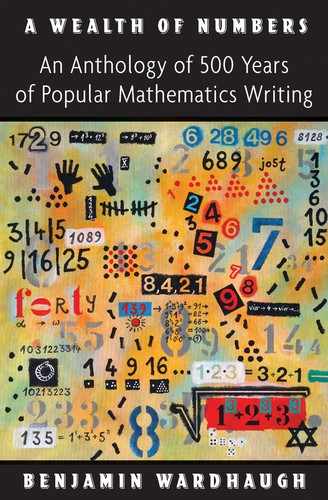Preface
![]()
HOW DID ORDINARY PEOPLE THINK ABOUT MATHEMATICS IN THE PAST? How did they write about it? How did they learn it and teach it? If—like me—you think those questions are fascinating, read on.
Mathematics has been written about and thought about in all kinds of different ways over the centuries, and, since the beginning of printing more than 500 years ago, whole genres of mathematical writing have appeared and, often, disappeared. This book brings together a taste of many of those kinds of writing. As a result, it’s more like a spice rack than a finished recipe—a rambling garden of delights rather than an orderly display of prize blooms.
That said, these hundred extracts do add up to something more than themselves: a history of mathematics which shows the subject through the eyes of the interested and the curious from the sixteenth century to the present. A history in which the changes that come are in the agendas of the writers and the interests of their readers: different mathematical audiences, different social contexts, different senses of the use of mathematics and the point of thinking about it.
So this is not a history of mathematical research or of new mathematics, not a story in which discoveries and innovations feature very largely or where the names of the writers are, often, ones you’ll have heard before (or ever hear again).
The eleven chapters take the story in different directions, looking at how mathematics was learned and taught, used at work and played with in spare time, reflected on, and laughed about. Some chapters (1, 3, 5, and 7) look at mathematics done for fun: games and puzzles, popularizations and histories. Others (Chapters 2, 4, 6, and 8) show it in the classroom and at work. Chapters 9 and 10 are more reflective, asking how mathematics should be learned and taught, and why. And we end in Chapter 11 with my own favorite: mathematics in fiction.
The only problem with putting together this book has been an embarrassment of riches; there is just so much writing about mathematics aimed at ordinary people, and it is so varied in so many ways, producing a sense of almost ludicrous inadequacy in anyone who tries to make a selection. I’ve tried to show as much of that diversity as I can, but I hope you’ll finish the book, as I do, wishing for more. It’s all here: mainstream or eccentric, famous or obscure, elegant or odd. The only cutoffs are that it must be aimed at readers with school-level mathematics (or less) and that it must be published (and in English, though early translations count).
Further Reading
If you are interested in the “higher” mathematics of the past, and the mathematical writing that was written for specialists rather than ordinary people, one of the best anthologies is Jacqueline Stedall, Mathematics Emerging: A Sourcebook 1540–1900 (Oxford, 2008). For a broad take on mathematics as a global phenomenon, there’s Marcia Ascher, Mathematics Elsewhere: An Exploration of Ideas across Cultures (Princeton, 2002). A superlative compendium of recreational mathematics is Elwyn R. Berlekamp, John H. Conway, and Richard K. Guy, Winning Ways for Your Mathematical Plays (Academic Press, 1982). And, finally, if you’d like a little help in reading and thinking about mathematical writings from the past, you might try my own How to Read Historical Mathematics (Princeton, 2010).
Note on the Text
These extracts come from books, magazines, newspapers, and websites over a period of more than 400 years, and their original language and presentation vary extremely widely. I have striven for a consistent presentation rather than one which preserves sometimes distracting idiosyncrasies (of spelling, punctuation, or layout, for instance) for their own sake. So spelling, punctuation, and the use of italics have been modernized throughout. Obvious errors in the original texts (which are very rare) have been corrected, abbreviations expanded, and references to figures inserted, without comment. Other changes and omissions are marked with ![]() , though rather than carry this to extremes, I occasionally present a whole extract as a paraphrase where the original language seems otherwise impenetrable; these cases are noted as they appear. Longer omitted sections are marked with this symbol:
, though rather than carry this to extremes, I occasionally present a whole extract as a paraphrase where the original language seems otherwise impenetrable; these cases are noted as they appear. Longer omitted sections are marked with this symbol: ![]() . The mathematical notation follows the original texts as far as possible—though modern typesetting often makes a huge difference in its appearance—and any exceptions are noted. Some extracts have a few explanatory notes, marked like this: °. They can be found at the end of the extract in question.
. The mathematical notation follows the original texts as far as possible—though modern typesetting often makes a huge difference in its appearance—and any exceptions are noted. Some extracts have a few explanatory notes, marked like this: °. They can be found at the end of the extract in question.
Acknowledgments
This book owes its existence and such merits as it possesses to the wise assistance and advice of many colleagues and friends, including Vickie Kearn, Stefani Wexler, and no fewer than six anonymous referees at Princeton University Press, as well as Jacqueline Stedall at Oxford University and, among my family, Jessica and Moira Wardhaugh. It owes its defects to me alone.
